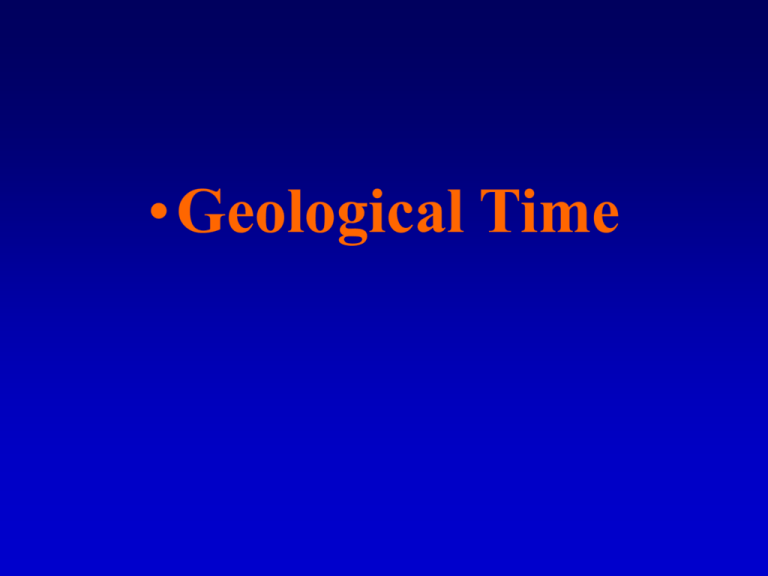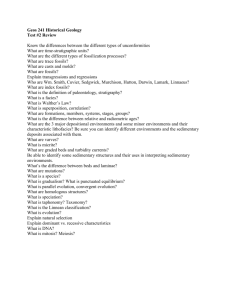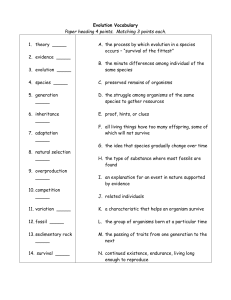Chapter 23 - "Geologic Time"
advertisement

•Geological Time • The Painted Desert, Arizona. This landscape has a story to tell, and each individual rock and even the colors mean something about the past. • Fossils • Early Ideas about Fossils – Herodotus • realized that fossil shells found far from oceans were remnants of an ancient sea. – Aristotle • Believed in Spontaneous Generation • Thought that fossils grew in place in rocks. – Leonardo da Vinci • Argued that fossils were remnants of living organisms from the Earths past history. – William “Strata” Smith • Discovered a relationship among the strata from different areas. • Found that each strata has a distinct group of fossils associated with it and that these fossils were different from the fossils found in other strata. • Types of Fossilization – Preservation or alteration of hard parts • This is the actual preservation of the hard parts themselves • Could include shells, bones, exoskeletons, etc… – Preservation of the shape • Mineralization – The filling of pores with calcium carbonate, silica, or pyrite • Replacement – Dissolving of the original material and depositing new material one ion at a time (ion exchange) – Preservation of signs of activity • Footprints • Bones of prey • The fossil record of the hard parts is beautifully preserved, along with a carbon film, showing a detailed outline of the fish and some of its internal structure. • Origin of molds and casts. (A) Formation of a mold. (B) Formation of a cast. • These logs of petrified wood are in the Petrified Forest National Park, Arizona. • Reading Rocks • Arranging Events in Order – Principle of uniformity • Stated that the present is the key to the past. • Look at geological features of today’s Earth as being shaped by its past. • States that the processes that are going on today to shape the Earth are the same processes that have always been going on. – Principal of original horizontality • Based on the premise that sedimentary rock is deposited in flat-lying layers. • This means that if a sedimentary layer is not horizontal, it has been subjected to forces that have moved or changed it. • If it is horizontal, we can use this to study organisms that lived on the Earth during the same periods of time. • The principle of original horizontality. (A) Sediments tend to be deposited in horizontal layers. (B) Even where the sediments are draped over an irregular surface, they tend toward the horizontal. – Principal of superposition • As sedimentary layers are laid down they are compacted and cemented together, which keeps the organisms in that layer together. • The principle of superposition. In an undisturbed sedimentary sequence, the rocks on the bottom were deposited first, and the depositional ages decrease as you progress to the top of the pile. • The Grand Canyon, Arizona, provides a majestic cross section of horizontal sedimentary rocks. According to the principle of superposition, traveling deeper and deeper into the Grand Canyon means that you are moving into older and older rocks. – Principal of crosscutting relationships • Any igneous or metamorphic rock that cuts across a sedimentary strata must be younger than the layer it crosscuts. • This is helpful in tracking events in the Earth’s history. – Shifting sites of erosion and deposition • As sedimentary rock is eroded and moved to another place, there will always be a time lapse between the shifting and the compacting and cementing. • A granite intrusion cutting across older rocks. – Unconformity • States that as there is a time lapse between sedimentation and compacting and cementing there will be a surface break within the sedimentary deposition. – Angular unconformity • This is where the bedding planes above and below the area of unconformity are not parallel. • This is due to tilting or folding followed by a period of erosion and a period of deposition. • Angular unconformity. Development involved some deformation and erosion before sedimentation is resumed. • A time break in the rock record in the Grand Canyon, Arizona. The horizontal sedimentary rock layers overlie almost vertically foliated metamorphic rocks. Metamorphic rocks form deep in the earth, so they must have been uplifted, and the overlying • Correlation – Principal of faunal succession • Recognizes that life has changed throughout time. • As one group of organisms disappears from the fossil record it is replaced with new ones. • The same form is never exactly duplicated • This allows fossils to be put in chronological order based on their appearance in the strata and the fossil record. – Index Fossils • A fossil that occurred widely, but for a very brief time period. – Correlation • The use of index fossils and the other methods of reading fossils to make it possible to compare rocks that have been exposed in two locations – Relative dating • Fossil dating using these methods is called relative dating. • It is a way of dating fossils and geological events relative to other fossils and geological events. • Deciphering a complex rock sequence. The limestones must be oldest (law of superposition), followed by the shales. The granite and basalt must both be younger than the limestone they crosscut (note the metamorphosed zone around the granite). It is not possible to tell whether the igneous rocks predate or postdate the shales or to determine whether the sedimentary rocks were tilted before or after the igneous rocks were emplaced. After the limestones and shales were tilted, they were eroded, and then the sandstones were deposited on top. Finally, the lava flow covered the entire sequence. • Similarity of fossils suggests similarity of ages, even in different rocks widely separated in space. • This dinosaur footprint is in shale near Tuba City, Arizona. It tells you something about the relative age of the shale, since it must have been soft mud when the dinosaur stepped here. • (A)Fossil trilobites from Cambrian rocks. (B) Fossil ammonites from Permian rocks. • Geological Time • Early Attempts at Earth Dating – Introduction • Archbishop Ussher of Ireland counted up the generations of people mentioned in the Bible and decided that the Earth was created at 9:00 AM on Tuesday, October 26 4004 BC • At the end of the 18th century James Hutton reasoned that the Earth must be much older • People began to look for a way of dating the Earth using some sort of Geological Clock. – Geological Clocks • Process must have been present since the Earth was first created • The process must occur at a uniform rate • The process must be able to be measured – Clocks considered • Rate of salt addition to the ocean – Resulted in an age for the Earth of 100 million years • Rate of sediment deposition – Resulted in an age for the Earth of 20 to 1,500 million Years • Rate of cooling of the Earth – Resulted in an age for the Earth of 20 to 40 million • Modern Techniques – Radioactive decay • Measure the rate of radioactive decay of unstable elements within the crystals of certain elements. • Since decay rates are constant the ratio of the decay product to the remaining amount of the original element can be used as a measure of the age of the material in which it is found. – Geomagnetic time scale • Looks at the duration and number of magnetic field reversals occurring during the past 6 million years. • Used in combination with Radiometric dating. • The Geological Time Scale – Eras • Cenezoic – Time of recent life – Fossils resemble modern day living organisms • Mesazoic – Time of middle life. – Some fossils resemble modern day living organisms – Some are different from any living organism on the Earth today. • Paleozoic – Time of ancient life. – Fossils are different from anything found on the Earth today. • Precambrian – Time before the time of ancient life. – Very few fossils are found in this time period – Periods • Eras were further divided into Periods – Epochs • Periods are further divided into Epochs • Geologic history is divided into four main eras. The Precambrian era was first, lasting the first 4 billion years, or about 85 percent of the total 4.6 billion years of geologic time. The Paleozoic lasted about 10 percent of geologic time, the Mesozoic about 4 percent, and the Cenozoic only about 1.5 percent of all geologic time. • The divisions of the geologic time scale. • The periods of the Paleozoic era, which refers to the time of ancient life. Ancient life means that the fossils for this time period are very different form anything living on the earth today. Each period represents a dominant life form of a different species of animal. This pie chart compares the relative time that each period lasted.








